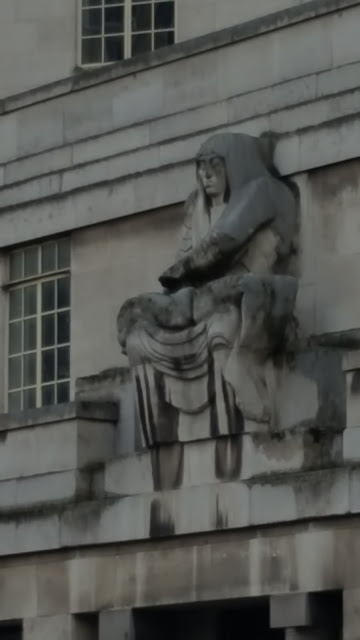The Hidden London tours can be booked via the London Transport Museum's website. Tours often sell out, so it is advisable to book early. Friends of the London Transport Museum are given advanced booking and discounted rates.
The tour started in the reception are of 55 Broadway. Originally this used to be a thoroughfare for passengers, but it has since been closed off (although some passengers still try to access the station though it).
After the introduction and an explanation of an analogue train counter (basically a system where on each line, once a train had passed a certain point, an electronic signal was sent to the machine, which would make a mark against a paper disc, providing a visual representation of the frequency of service (apologies, no photos from me, but you can always check out this one)) - our tour headed outside so that our guides could provide some background on the building's architecture.
The architect, Charles Holden, had been working on commission for the Underground Electric Railways Company of London (UERL) for a number of years, after originally being tasked by the General Manager, Frank Pick, to design a side entrance to Westminster tube station.
There followed a number of of further commissions for the UERL, culminating with the job of designing a new headquarters.
Holden's design was a cruciform shape with receding upper levels to maximise the amount of daylight received inside. The building, clad in Portland stone, was built on a steel frame, and at the time was the tallest office building in London, standing several metres higher than Big Ben (although coming short of St Paul's Cathedral).
Back inside the building, the tour continued to the second floor, and one of the still in-use offices. Plans had been announced (several years ago) for the building to be vacated by London Underground and converted to residential use (i.e. turned into flats for Russian oligarchs to buy as investments and then leave vacant) - however, various complications (including the building's Grade 1 listed status) seem to have delayed that - at the moment the building has been sold and leased-back by Transport for London.
Moving upwards, the tour arrived at the end of a long wood-panelled corridor at the former office of the Chairman.
Now used as a meeting space, visitors would previously have had to pass the gauntlet of two different secretaries, both in their own offices (now knocked together into a single meeting room), before arriving in the office, where they would cross the wide floor before arriving at the Chairman's desk in the far corner.
Even then, the visitor would still have to wait before the Chairman would deign to pay them attention.
Due to limited access to the roof, the group split in two on floor 10 of the tour. Considering the UK was being battered by gale force winds at the time, it was only at the last minute that we were given permission to proceed.
Access to the roof was obtained a number of metal access stairs and via the room that was previously used to hold the clockwork of 55 Broadway's external clocks (they're now driven electrically).
Despite being a mere tiddler of a building when it comes to modern skyscrapers in London, the view from the roof is still impressive, particularly with the Westminster surroundings, which include Westminster Abbey and Buckingham Palace among the sights.
Back on the tenth floor, while waiting for the second group to complete their rooftop tour, our group was shown a short film, accompanied by tea and biscuits (an appropriately English repast), and provided a quick trip out to one of the roof gardens on the level.
According to one of our guides, in the days when coal fires were used in the building, staff would on occasion use one of the chimneys to their advantage. A certain manager was known for working past midnight, and his staff were expected to stay at work with him. At times, to encourage him to leave, staff would come up to the roof and block the chimney, effectively smoking him out of his office.
The tour ended by descending a staircase to the ground floor, the staircase itself ahead of its time with a couple of features - including rounded corners on the steps and markers on the edges of the steps to make the descent that bit safer. Landings on the staircase also provide a glimpse into the London Underground's past with signs from its substantial heritage.


























No comments:
Post a Comment